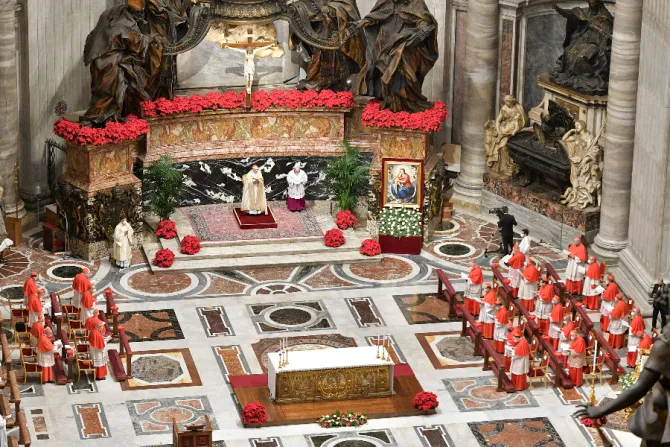A consistory for the creation of new cardinals in St. Peter’s Basilica Nov. 28, 2020. | Vatican Media.
On Saturday 27th August, Pope Francis will place a red biretta on the heads of 18 bishops and two priests, declaring them to be cardinals “to the glory of almighty God and the honour of the Apostolic See.”
Here’s what you need to know:
What is a consistory?
A consistory is a formal meeting of the College of Cardinals. The pope can convene them for several different reasons.
One of the most common reasons for a consistory is to create new cardinals. The ceremony in which the pope makes cardinals is an ordinary public consistory.
In addition to the red biretta, at the Aug. 27 ceremony, Pope Francis will also place a ring on the hand of each new cardinal while saying: “Receive this ring from the hand of Peter and know that, with the love of the Prince of the Apostles, your love for the Church is strengthened.”
The pope will also assign each new cardinal a church in the Diocese of Rome, called a “titular church.” This further links the cardinal to Rome and to the pope, who is the Bishop of Rome.
The other members of the College of Cardinals, clergy, Catholics, and members of the public may all attend a consistory to create cardinals.
Another consistory the pope may convene is an ordinary consistory to vote on the causes of new saints, the last step before a formal canonisation can take place.
There are also extraordinary consistories, which every cardinal is expected to take part in, barring a serious reason.
The three consistories of August
The consistory to create cardinals on Aug. 27 will be an ordinary consistory, open to the public.
A second public ordinary consistory will immediately follow it for cardinals to give their approval for the canonisations of two blesseds: Giovanni Battista Scalabrini, an Italian bishop and founder of the Missionaries of St. Charles, and Artemide Zatti, an Italian immigrant to Argentina who was a nurse and Salesian Coadjutor Brother.
Pope Francis has also called for an extraordinary consistory to take place Aug. 29-30.
With this third consistory, the pope has asked the world’s cardinals to come to Rome to discuss the new constitution of the Roman Curia, Praedicate evangelium.
This will be only the third extraordinary consistory of Francis’ pontificate and the first to take place in seven years.
At the end of the two-day meeting, in the afternoon of Aug. 30, Pope Francis will celebrate Mass with the new cardinals and the entire College of Cardinals in St. Peter’s Basilica.
A trip in the middle
In between all of these consistories, on Aug. 28, Pope Francis will travel for half a day to the central Italian city of L’Aquila for an important annual event, the Celestinian Forgiveness.
The Celestinian Forgiveness (Perdonanza Celestiniana in Italian) is a legacy of Pope Celestine V, who reigned from July 5, 1294, to Dec. 13 of the same year, when he resigned.
Both a controversial and revolutionary figure, Celestine V established the Celestinian Forgiveness, which offers a plenary indulgence to all who, having confessed and repented of their sins, go to the Basilica of Santa Maria di Collemaggio in L’Aquila from Vespers on Aug. 28 to sunset on Aug. 29.
In L’Aquila, Pope Francis will celebrate Mass outside the Basilica of Santa Maria di Collemaggio before opening the church’s Holy Door.
He will also make a private visit to the city’s cathedral, which is still in disrepair after sustaining severe damage in a 2009 earthquake that killed more than 300 people in L’Aquila and the surrounding area. Following the visit, he will greet the family members of people who died in the quake.
132 cardinal electors
With the August consistory, the College of Cardinals will have 132 cardinal electors — that is, cardinals under the age of 80 and thus eligible to vote for a new pope in a conclave.
Of these 132 cardinals, Pope Francis will have chosen 83, 62% of cardinal electors. By the end of 2022, when six more cardinals will have turned 80 years old, this percentage will be 65.
The quorum for the election of a pope is two-thirds or 84 cardinals. At the end of 2022, the cardinals created by Pope Francis will only be two less than the quota necessary to elect a successor.
In the Aug. 27 consistory, Pope Francis will also create four new cardinal non-electors, men over the age of 80. Pope Francis had initially named five but later accepted a Belgian Catholic bishop’s request not to be made a cardinal.
An unconventional date
This will be Pope Francis’ eighth consistory to create new cardinals, but the first time the ceremony has been held in August, typically a time of rest in Rome and the Roman Curia due to the intense summer heat.
The last time a cardinal was created in August was over 200 years ago, in 1807, when Pope Pius VII made Francesco Guidobono Cavalchini a cardinal “in pectore,” or in secret. The new cardinal’s name was not announced until the following year.
Source: CNA

